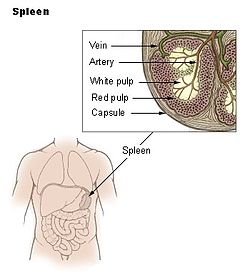Marginal zone
| Marginal zone | |
|---|---|
 | |
| Identifiers | |
| FMA | 15852 |
| Anatomical terminology | |
The marginal zone is the region at the interface between the non-lymphoid
A marginal zone also exists in lymph nodes.[1][2]
Structure
It is composed of cells derived primarily from the
Blood flow
The marginal zone (MZ) is a highly transited area that receives large amounts of blood from the general circulation. Remarkably, the splenic
Function
The major role of marginal zone is to trap
Experiments have shown that inert
Lymphocytes
Marginal zone
Marginal zone macrophages
Within the marginal zone there exists two types of macrophages that are unique to this area: the marginal zone macrophages and the marginal metallophilic macrophages. These two macrophage sub-types are characterized by the expression of SIGN-R1 on the marginal zone macrophages and CD169 (siglec-1, sialoadhesin) on the marginal metallophilic macrophages.
In addition to the marginal zone B-cells that normally reside there, a number of other cell types that are present in the blood pass through the marginal zone e.g. lymphocytes and granulocytes. In addition, a large number of dendritic cells are thought to reside temporarily in the marginal zone before migrating into the white pulp following stimulation and antigen uptake, as well as a large number of lymphocytes remaining in the marginal zone for a period of time during the process of transmigration into the white pulp. It can be assumed that both of these cells will interact with the marginal zone macrophages.
Recent studies have shown that the marginal zone macrophages possess both important innate functions, as well as being able to promote adaptive immune responses, so these macrophages can bridge the innate and adaptive immunity.
The marginal zone macrophages have a variety of functions, one of which is the phagocytosis of blood-borne pathogens. Because of the anatomy of the marginal zone, the blood within it slows down and therefore the pathogens present in the systemic circulation are phagocytosed by both marginal zone macrophages. There is limited data regarding the specific roles of these two macrophage subsets in the uptake and eradication of pathogens. However there is evidence and reports that show there is a specific involvement of the various pathogen receptors on the marginal zone macrophages in recognising and eliminating certain pathogens, especially encapsulated bacteria. For example, the C-type lectin SIGN-R1 receptor (present on the marginal zone macrophages), mediates the recognition of pneumococcal saccharides and is necessary for Streptococcus pneumoniae clearance.
Furthermore, both types of marginal zone macrophages are involved in the clearance and degradation of viruses e.g. cowpox virus and adenovirus serotype 5. Evidence has shown that the clearance of lymphocytic choriomeningitis virus by marginal zone macrophages is crucial to prevent the spreading of viral infections to peripheral organs.[7]
See also
- Marginal zone B-cell lymphoma
- Humoral immunity
References
External links
- Pillai S, Cariappa A, Moran ST (2005). "Marginal zone B cells". Annual Review of Immunology. 23: 161–96. PMID 15771569.
- Ferguson AR, Corley RB (2005). "Accumulation of marginal zone B cells and accelerated loss of follicular dendritic cells in NF-κB p50-deficient mice". BMC Immunology. 6: 8. PMID 15836790.
- Marginal zone lymphomas
- Song H, Cerny J (December 2003). "Functional heterogeneity of marginal zone B cells revealed by their ability to generate both early antibody-forming cells and germinal centers with hypermutation and memory in response to a T-dependent antigen". The Journal of Experimental Medicine. 198 (12): 1923–35. PMID 14662910.
- Kraal G (1992). "Cells in the marginal zone of the spleen". International Review of Cytology. 132: 31–74. PMID 1555921.
- Kumararatne DS, MacLennan IC (November 1981). "Cells of the marginal zone of the spleen are lymphocytes derived from recirculating precursors". European Journal of Immunology. 11 (11): 865–9. S2CID 22799132.
